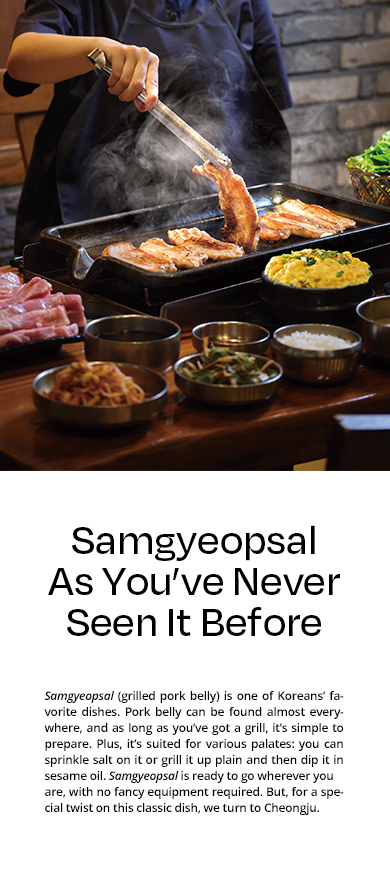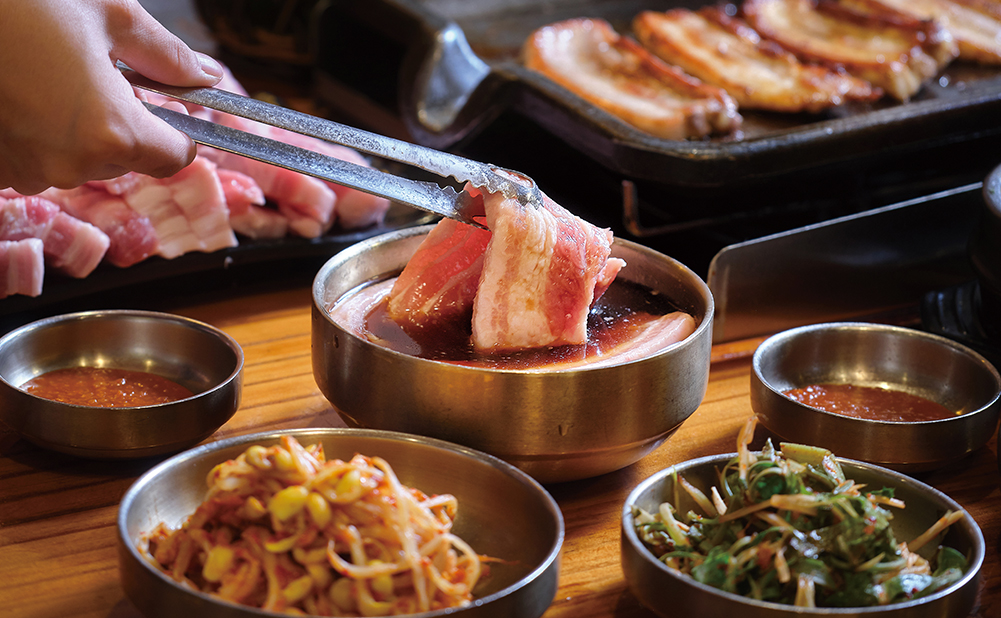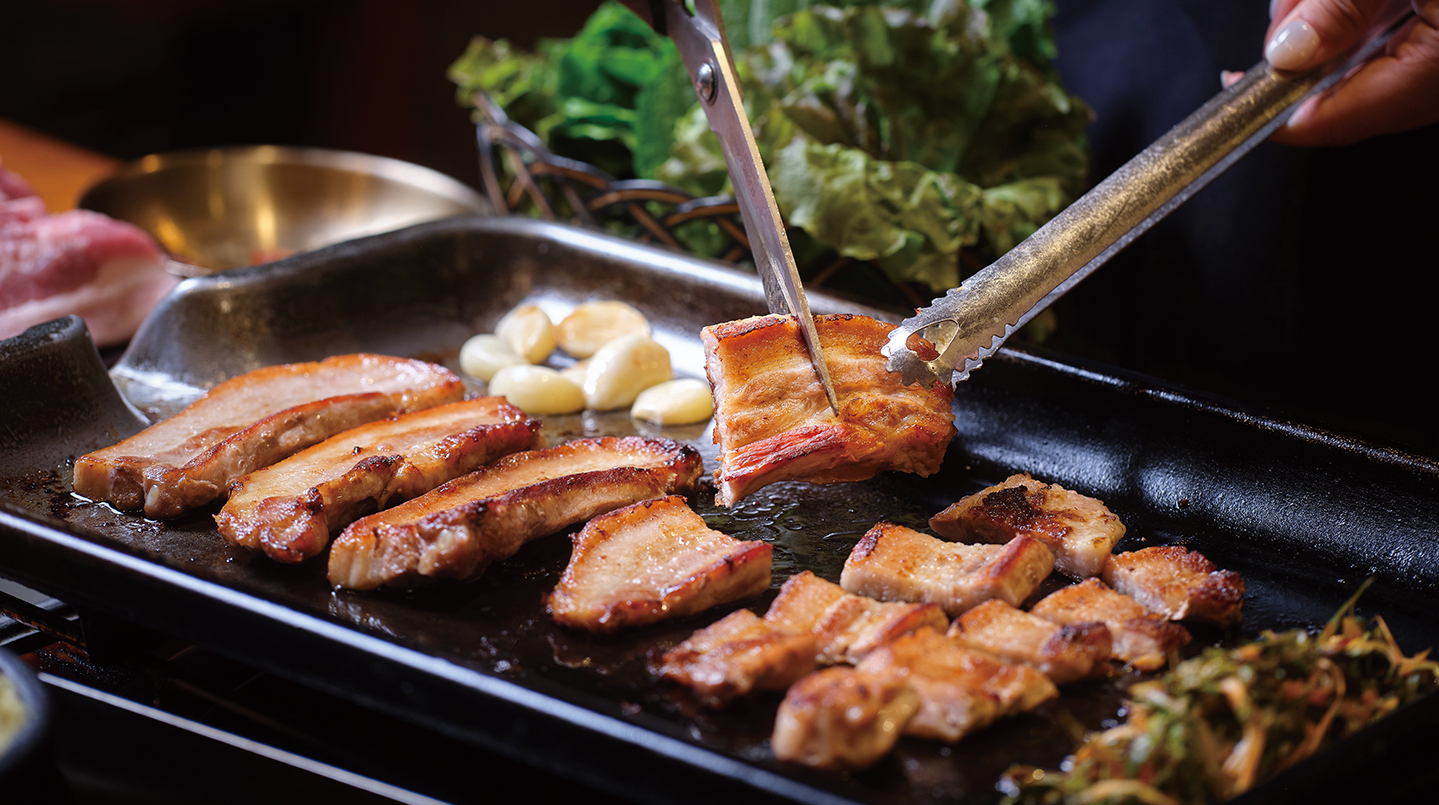October 2023

Local
Dining


Samgyeopsal Gets the Ganjang Treatment
While samgyeopsal is generally prepared on a grill, residents of Cheongju enjoy dipping their pork belly in ganjang (soy sauce) before popping it on the grill. The ganjang marinade is made with vegetables such as ginger and daepa (large green onions) and spices like cinnamon and bay leaf.
So, what’s the point of adding ganjang to samgyeopsal in Cheongju? In the past, uncastrated male pigs (boars) were butchered for their meat, which often resulted in an unpleasant odor called boar taint. Cooks tried adding ganjang to pork belly to eliminate that smell, which had the unintended effect of tenderizing the meat. Soon, customers began seeking out ganjang samgyeopsal. That trend settled into a tradition that’s now a distinctive feature of Cheongju samgyeopsal.
Cheongju’s distinctive take on samgyeopsal, which is now officially known as Cheongju samgyeopsal, is becoming known as a regional delicacy. There’s even an alley dedicated to Cheongju-style samgyeopsal in Seomun Market. Stroll around the market in the morning, and you’ll encounter the syrupy smell of ganjang on the boil; come back in the evening, and you’ll smell the mouthwatering aroma of samgyeopsal being grilled at every restaurant.

Cheongju samgyeopsal is marinated in ganjang and then grilled.
Many Flavors to Savor
While all Cheongju samgyeopsal is marinated in ganjang, there’s a unique flavor to savor at each restaurant. The flavor depends on the type of grill that’s in use: the choice of a regular old grill or a cauldron lid can have a big impact on how crispy the outside is, for example, and the question of whether to put cooking foil on the grill or not is important, too. The flavor is also impacted by whether the pork belly is chilled or frozen, what ingredients are added to the ganjang marinade, and how much marinade goes on the grill. The side dishes served with the ganjang samgyeopsal can turn it into something else entirely. One samgyeopsal restaurant in Cheongju recommends stir-frying their pork belly with pamuchim (green onion salad), which adds sour and spicy overtones that are missing from ordinary ganjang samgyeopsal.

After placing the pork belly on the grill and browning it on both sides, cut the samgyeopsal into bite-sized pieces using tongs and scissors.
Good to the Very Last Bite
While every restaurant has its own method of preparing samgyeopsal, if you want crispy outside samgyeopsal, dip the strips of meat lightly in the ganjang marinade and then plop them directly onto the heated grill. Once you hear a sizzle, flip the meat over once, and then once more.
If you prefer juicy samgyeopsal, you should drizzle the marinade over the meat before grilling it all the way through. That serves to steam the meat, ensuring that both inside and out are tender. Another way to adjust the flavor is to pour the marinade over the meat while it’s grilling, which can make it saltier. But really, cook it however you like!
Once the meat is done, place a layer of sour and piquant pamuchim on a lettuce leaf and add a hunk of samgyeopsal on top. You may also want to slather on a condiment of your choice, such as gochujang (red chili paste) or ssamjang (red chili soybean paste). Soon, your taste buds will sing a flavorful symphony: savory ganjang, rich samgyeopsal and tart pamuchim.
If some meat and side dishes are still on the table as your meal draws to a close, you can ask the staff to whip up a Korean-style “dessert”―that is, bokkeumbap (fried rice). Rice, egg, gim (laver) and sesame oil are served in a big brass bowl. Those ingredients make a good stir-fry by themselves, but what’s even better is chopping up leftover samgyeopsal and some kimchi or kongnamulmuchim (bean sprout salad) and adding them to the mix.
When your bokkeumbap is starting to cook, flatten it out on the grill and let it sit for a while. A crunchy crust will form on the bottom of the bokkeumbap, making for a delicious treat, especially when you’ve mixed in some of that savory ganjang samgyeopsal.
So, if you’re interested in trying out a fresh take on Korea’s ubiquitous samgyeopsal, you can’t go wrong with Cheongju’s ganjang samgyeopsal. The experience varies with each restaurant, not to mention each diner, making your meal something more interesting than just another chance to sate a hungry belly.

(Left) Ssamjang is a dipping sauce made by mixing doenjang (soybean paste), garlic, gochujang (red chili paste), sesame oil and so on, enhancing the flavor of the meat. ©TongRo Image
(Right) Bokkeumbap is a dish that Koreans often seek out as a finishing touch when enjoying tteokbokki (stir-fried rice cake), gamjatang (pork back-bone stew) and more.
 View of all
View of all






